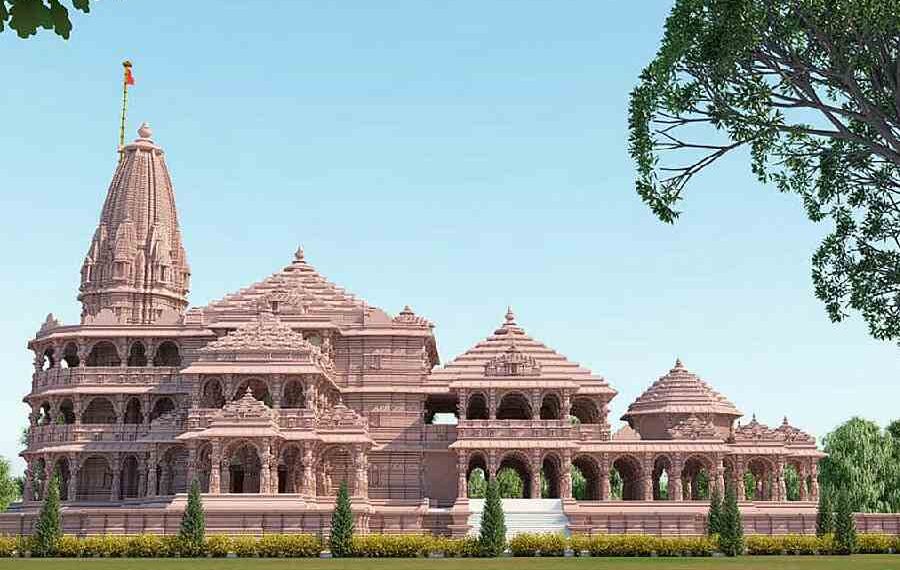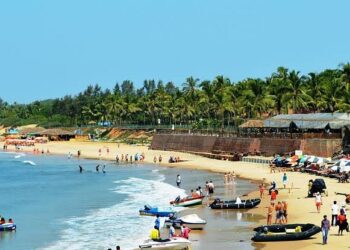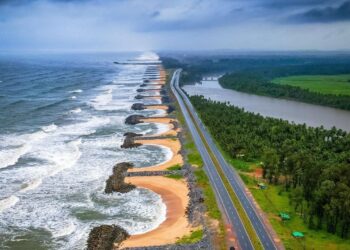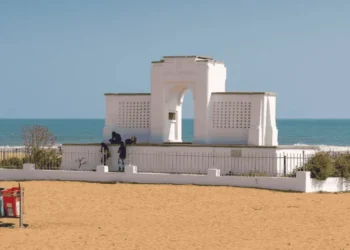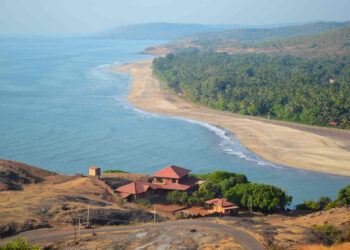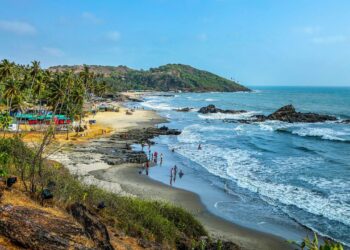Uttar Pradesh, one of the most divine space carrying India’s spiritual and historical legacy, houses temples that reflect centuries of faith, artistry, and tradition. From Varanasi’s ancient ghats to Ayodhya’s sacred riverbanks, each shrine carries a distinct story. This blog explores 21 notable temples in the divine land of Uttar Pradesh of India.
1) Kashi Vishwanath Temple, Varanasi
In Varanasi’s crowded lanes, Kashi Vishwanath Temple, one of 12 Jyotirlingas, reveres Lord Shiva. Its spire, layered with 800 kilograms of gold by Maharaja Ranjit Singh in 1835, rises above the Ganges. Rebuilt in 1780 by Ahilyabai Holkar after invasions, it draws pilgrims who believe prayers and a Ganges bath ensure salvation. Priests perform aarti at dawn and is one of the attractions among devotees.
2) Ram Janmabhoomi Temple, Ayodhya
Ayodhya’s Ram Janmabhoomi Temple marks Lord Rama’s birthplace. Completed in January 2024, its 392 Nagara-style pillars depict Ramayana carvings. Once a site of conflict, it now unites devotees along the Sarayu River. Local priests recount how pilgrims offer lotus flowers during evening rituals, a practice rooted in ancient texts.
3) Banke Bihari Temple, Vrindavan
Banke Bihari Temple in Vrindavan enshrines Lord Krishna in his three-fold pose. Founded in the 16th century by Swami Haridas, it limits deity viewings to brief moments, fearing Krishna’s gaze might overwhelm. Locals say the temple’s bells, rung at dusk, signal peace across Vrindavan’s lanes.
4) Prem Mandir, Vrindavan
Prem Mandir, established in 2001 by Jagadguru Kripalu Ji Maharaj, commemorates Radha and Krishna’s divine bond. Its 54-acre marble structure, carved with Krishna’s life, shines under torchlight. Devotees tie padlocks to railings, praying for lasting love as a unique custom. The temple’s gardens bloom with marigolds, tended by local volunteers.
5) Krishna Janmabhoomi Temple, Mathura
Mathura’s Krishna Janmabhoomi Temple claims the prison cell where Lord Krishna was born. Rebuilt post-Mughal destruction, it merges old stones with new halls. Janmashtami sees devotees light oil lamps, reenacting Krishna’s birth. A nearby mosque hints at historical dispute.
6) Dwarkadhish Temple, Mathura
Since 1814, Dwarkadhish Temple has honored Krishna as Dwarka’s king. Its Rajasthani gates and murals depict his divine rule. The Jhulan Yatra, with Krishna’s idol on a silver swing during monsoon, draws families. Villagers prepare handmade garlands, a tradition passed down for generations.
7) Baldev Dauji Temple, Mathura
Eighteen kilometers from Mathura, Baldev Dauji Temple reveres Balarama. Built in 1535 near Kshir Sagar pond, where his idol was found, it keeps a simple charm. During Holi, locals sing Braj folk songs, tossing colors to honor Balarama’s strength. The pond’s lotus blooms are offered in rituals.
8) Gorakhnath Temple, Gorakhpur
Goraktnath Temple, or Gorakhnath Math, venerates a divine saint linked to Shiva. A centuries-old flame burns in its sanctum, beside Mansarovar pond. Makar Sankranti brings thousands, their prayers rising with kites.
9) Sankat Mochan Hanuman Temple, Varanasi
Founded by Tulsidas in the 1500s, Sankat Mochan in Varanasi honors Hanuman. Its stone halls host Hanuman Chalisa recitations, especially Tuesdays. Monkeys, seen as Hanuman’s kin, roam the grounds. Devotees offer laddoos, believing they lift troubles.
10) Hanumangarhi Temple, Ayodhya
On Ayodhya’s hill, Hanumangarhi, built in the 10th century, reveres Hanuman. Its 76 steps symbolize devotion; murals depict Ramayana scenes. Pilgrims visit before Ram Janmabhoomi, seeking blessings. A priest described how oil lamps are lit at midnight during festivals, a tradition unique to this shrine.
11) Maa Vindhyavasini Temple, Vindhyachal
Maa Vindhyavasini, a Shakti Peeth in Mirzapur, enshrines Durga along the Ganges. Between Varanasi and Prayagraj, it hosts Navratri fairs with bangle stalls. Devotees believe prayers here are answered. Locals recall a 19th-century flood when the goddess’s idol was saved by villagers.
12) Naimisharanya Temple, Sitapur
Naimisharanya, a Vishnu site, is where Puranas say sages recited Vedas. Scholars visit to study ancient texts. A tree where pilgrims tie threads for blessings is a lesser-known ritual in this temple.
13) Chandrika Devi Temple, Lucknow
Chandrika Devi, near Lucknow, honors Durga, tied to the Ramayana via Lakshmana’s son. Navratri brings marigold offerings. Its myth of Durga slaying a demon draws devotees. Lamps are floated on a nearby pond during festivals as a tradition.
14) Tulsi Manas Temple, Varanasi
Built in 1964, Tulsi Manas marks where Tulsidas wrote the Ramcharitmanas. Its walls bear his verses, a literary treasure near the serene Assi River.
15) Bharat Mata Mandir, Varanasi
Opened in 1936 by Shiv Prasad Gupta, Bharat Mata Mandir worships Mother India. A marble map, carved to scale, fills the sanctum of the temple blending faith and patriotism.
16) Jwala Devi Temple, Sonbhadra
Jwala Devi, a Shakti Peeth, reveres Jwalamukhi via a natural flame. Its hilly isolation aids meditation. Pilgrims carry oil lamps, seeking blessings from the mother goddess.
17) Narmadeshwar Mandir (Frog Temple), Lakhimpur Kheri
Built in the 1860s by Raja Bakht Singh, Narmadeshwar Mandir features a Shiva lingam on a frog-crocodile statue. Tied to drought-ending prayers, it’s unique. A tradition is shared here, how farmers offer milk during droughts, believing it revives crops.
18) Mankameshwar Temple, Agra
Agra’s Mankameshwar, one of four Shiva shrines, is known for answered prayers. Near the Taj Mahal, it’s a quiet haven. The Shivalinga, believed to be encased in silver, is said to have been established by Lord Shiva himself during the Dwapara Yuga, the era in which Lord Krishna took birth in Mathura.
19) Bateshwarnath Dham, Agra
Bateshwarnath Dham, 101 Shiva temples by the Yamuna, links to the Mahabharata. Its riverside calm draws pilgrims. It is mentioned in several ancient scriptures and is believed to be the birthplace of Lord Krishna’s mother.
20) Lodheswar Mahadev Temple, Barabanki
Lodheswar Mahadev, a sacred Shivling, ties to Pandava rituals in the Mahabharata. Its stone walls hold centuries of worship. The Shivling enshrined in this temple is regarded as one of the rarest among the 52 Shivlings associated with the Shakti Pithas spread across India.
21) Gola Gokaran Nath Temple, Lakhimpur
Called Chhoti Kashi, Gola Gokaran Nath is dedicated to Lord Shiva, linked to Ravana’s penance. Situated in Gola Gokarannath, the Gola Gokaran Nath is also known as Choti Kashi.
